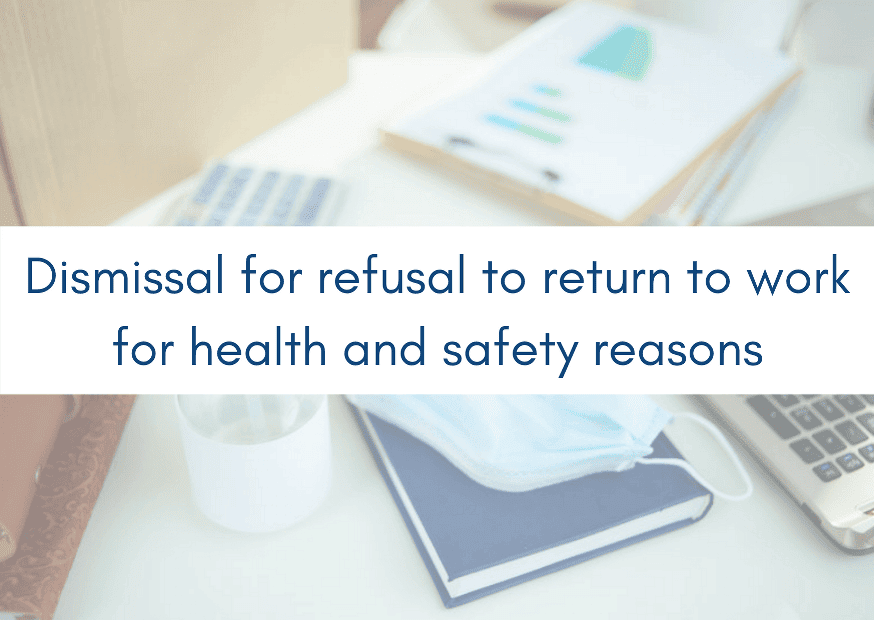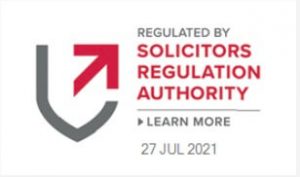As the first COVID-19 employment tribunal cases are starting to filter through the system, it allows us to see how the tribunals will approach cases concerning the health and safety risk that COVID-19 poses in the workplace.
One case that has highlighted concerns involves an employee who refused to return to work due to the risk of contracting Covid-19 in the workplace and was subsequently dismissed.
The case: Mr Rogers v Leeds Laser Cutting Limited
During the first lockdown in March 2020, Leeds Laser Cutting Limited tried to ensure their business was COVID safe. Employees were required to socially distance, wash their hands and there were extra cleaning measures in place.
Mr Rogers, an employee, left work on 27 March 2020 and informed his employer by text that he would not be returning to work on 29 March 2020. No further communication occurred and a few weeks later his employer decided to dismiss him. Mr Rogers brought a claim against his employer for unfair dismissal and relied on two elements based on health and safety grounds. It is important to note that Mr Rogers had less than 2 years’ service and could not claim normal unfair dismissal. His claim was for automatic unfair dismissal relating to health and safety concerns.
Health and Safety Grounds
The Tribunal considered section 100(1)(d) and (e) of the Employment Rights Act 1996.
(1) An employee who is dismissed shall be regarded for the purposes of this Part as unfairly dismissed if the reason (or, if more than one, the principal reason) for the dismissal is that:
(d) in circumstances of danger which the employee reasonably believed to be serious and imminent and which he could not reasonably have been expected to avert, he left (or proposed to leave) or (while the danger persisted) refused to return to his place of work or any dangerous part of his place of work, or
(e) in circumstances of danger which the employee reasonably believed to be serious and imminent, he took (or proposed to take) appropriate steps to protect himself or other persons from the danger.
Key questions and answers to take away from this case
- Is there a serious and imminent danger in the workplace?
Although Section 100 can be used as a defence in relation to COVID-19 concerns on the basis there are serious and imminent dangers, and the judge understood that Mr Rogers had wider concerns about COVID-19 and its effects considering the pandemic, Mr Rogers failed to provide specific evidence of the serious and imminent danger in the workplace.
Concerns should be specific to the workplace and not wider concerns about the effects of the pandemic from a social perspective.
- Will it be difficult for the work force to socially distance? Is the workplace safe?
Mr Rogers confirmed that it would not be ‘hard’ to socially distance in his workplace, he had also been given advice on how to remain safe in the workplace.
If the workplace is safe, the claim is likely to fail.
- Has the employee informed his employer of their specific concerns in relation to their place of work before not returning to work?
Mr Rogers did not take any responsible steps to protect himself and refusing to return to work with no explanations as to why was not a good enough defence. No concerns were raised, and no effort was made by Mr Rogers to explore other options which the employer could have made available to their workforce.
The employer should be given an opportunity to address these concerns and ensure that their workforce remain safe, and concerns are addressed in a timely manner.
If the employee does not raise their specific safety concerns their claim is likely to fail.
What should an employer do to reduce the risk of a claim and addresses its workforces’ concerns?
- Ask your employee what their specific concerns are and reassure them that you will take their concerns seriously and will look to provide a response in a timely manner. A progressive approach will show that you take their concerns seriously and that you care about the workforce’s wellbeing. By explaining measures, you will be able to hopefully reassure them.
- Be able to show evidence of COVID-safe measures in place, evidence of risk assessments which have been completed and that they remain up to date. A risk assessment completed several months ago may not be reassuring and could lead to issues if raised in an Employment Tribunal.
- Many of your workforce may have anxiety of returning to work, may be worried about their family who they live with who are vulnerable/may have health conditions. Ensure that you have a full picture and understand their concerns before reassuring them.
- You may find that their concerns are not justified but it is important to show that you are flexible, and you are able to provide alternative options. Is it possible for them to work from home? Could they change their hours of work to avoid large crowds? Could their role be altered slightly if they are currently required to complete duties that they are uncomfortable to complete considering the pandemic? Could you allow them to go on unpaid leave if it is not currently possible to change anything?
How can we support you?
As an employer, it is essential to have a risk assessment and health & safety policy in place to ensure that all cases are handled sensitively and consistently.
We understand that the above can be a difficult time for your employee from a social and wellbeing perspective too, and we are here to help.
If you would like us to review or complete an update of your company policies, then please get in touch at [email protected] or call 0333 888 1360 to speak with one of our expert advisors.







